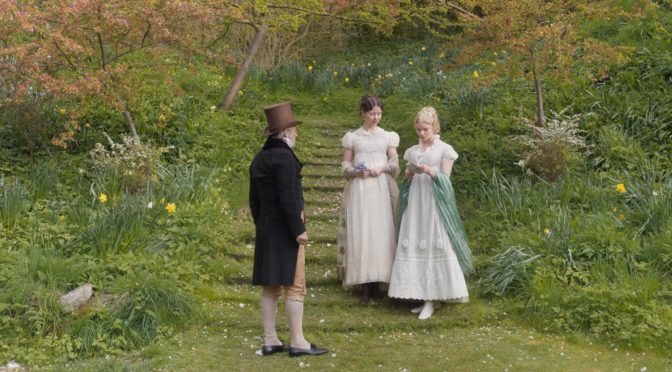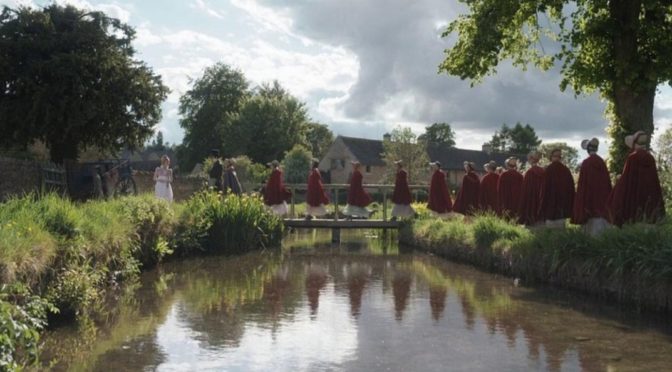Emma. is a readaptation of the novel by Jane Austen, already used as subject for several movies, including the iconic Clueless and a version starring Gwyneth Paltrow. The story is about a young aristocrat, Emma Woodhouse, who lives with her father in a graceful country house and has no great entertainment, other than plotting engagements for her friends, which she believes to be her greatest talent.
After the marriage of her housekeeper, Emma decides that she’ll also find a husband for her new friend Harriet, who has the serious problem of an unknown father. Emma believes that her friend can still get a good marriage and wants to set her up with Mr. Elton, the vicar of their village. In order to do that, she makes her turn down the offer of another less wealthy guy (even if Harriet has a crush on him) and encourages her interest in the priest. This happens despite Mr. Knightley, neighbor and dear friend of Emma, is helping the other suitor to make his proposal to Harriet and has good reasons to believe that Mr. Elton is not interested in the union that Emma is prospecting for him.
The plot is very dense and there are many other characters, Emma plays with everyone as if she was dealing with a dollhouse: she lives in a bubble, made up of her village, and has no ambition to go somewhere else, mainly because plotting and orchestrating the lives of those around her makes her feel powerful and superior. The only one who stands up to her and would like her to use her talents in a less superb way is Mr. Knightley, otherwise Emma acts undisturbed, with even Harriet’s deepest admiration.
This version shows a year in Emma’s life, following the course of the seasons and perhaps, not surprisingly, it begins with autumn (since the director’s name is Autumn). This construction divides the plot into four acts, like a play, and emphasizes the peculiarities of each season, which are fundamental for the costumes and the characterization of the characters linked to them. Everyone’s style is indeed very personal and, as reported by the costume designer, in the case of Emma, the queen bee of the story, the best way to show it was to make her wear the perfect dress for every event, every day, in every season. Each season is associated to a specific color palette, so the temporal change implies the one of the clothes and underlines how Emma imposes herself in many subtle ways in the story.
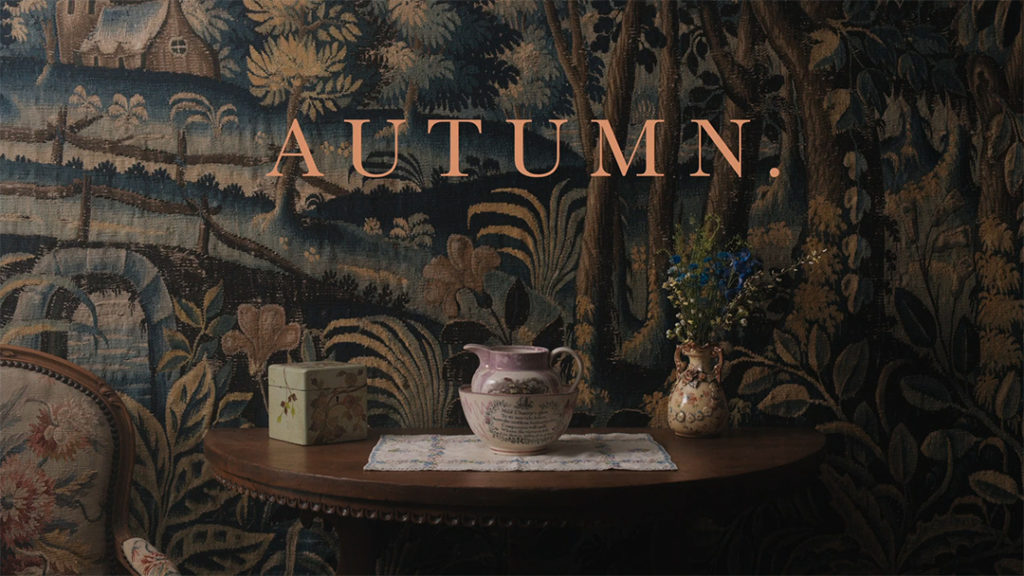
Costume designer Alexandra Byrne (2007 Oscar winner for Elisabeth: The Golden Age) has created historically accurate pieces, which are inspired by paintings and images of the first fashion magazines, born in the Georgian era in which the film is set. Harriet, for example, has a sort of school’s uniform, characterized by a red cape, historically documented. Over the course of the story, the more she binds to Emma, the more she begins to absorb her style, following the fashion of the time, making explicit the relationship between them.
The costumes make us perceive, as it was confirmed by Anya Taylor-Joy, who played the main character, that the clothes were fundamental for the actors to create characters. This is central for Emma, who is very self-confident, aware that a certain dress is perfect for her and able to imperceptibly show it. For example, in the scene where she paints a portrait of Harriet to impress Mr. Elton, she wants to highlight her friend but she’s the center anyway. The vicar, indeed, tries not to look at her neckline, which is subtly accentuated by some kind of collar she wears.
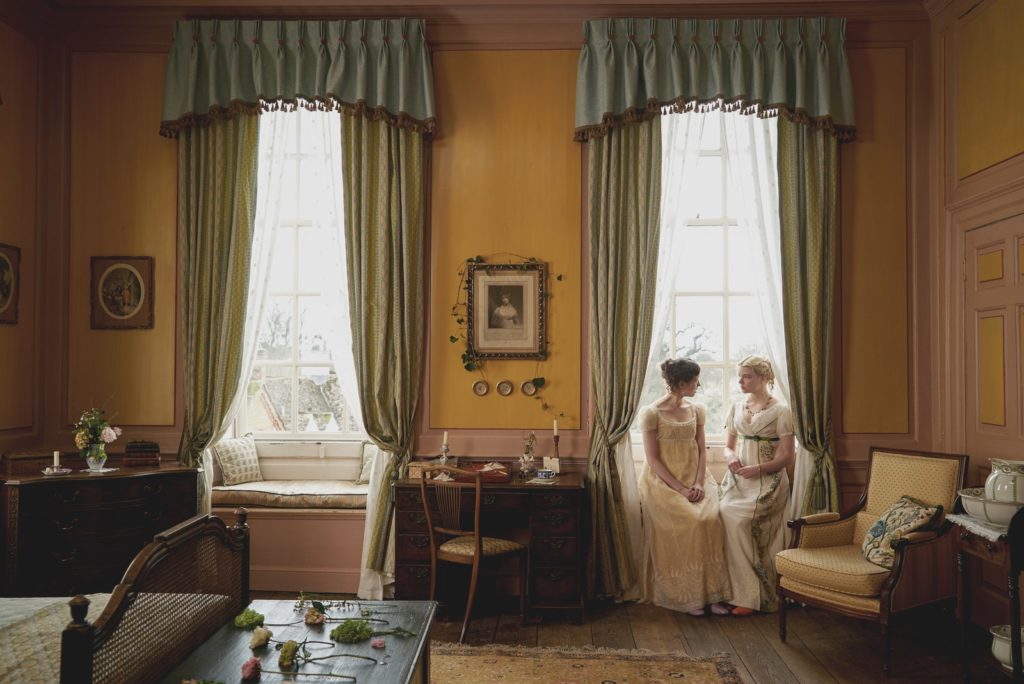
One of the strengths of this work is that all departments have worked closely, creating a cohesive result. Some characters’ costumes, such as those of Mrs. Elton, were designed according to the set designers to give the idea of who was foreign to a certain environment and who was not. This is especially clear when Mrs. Elton visits Emma and her father in their mansion, because her orange dress stands out from the other furniture and clothes.
Talking about Emma’s house, it’s fair to spend some words about it: the crew looked for a place that was from the Georgian period and that had never been used for a movie before. For the director it was essential that everything was historically accurate, so the rooms were furnished in a meticulous way, giving them, for example, the original colors of the walls, which are almost never seen in period movie. Furthermore, the house had to be a sort of dollhouse in which the main character could plan all her plots, so each room was created under this directive, with a specific color that is increasingly bright (the living room is pastel green, the stairs almost bright blue. , etc).
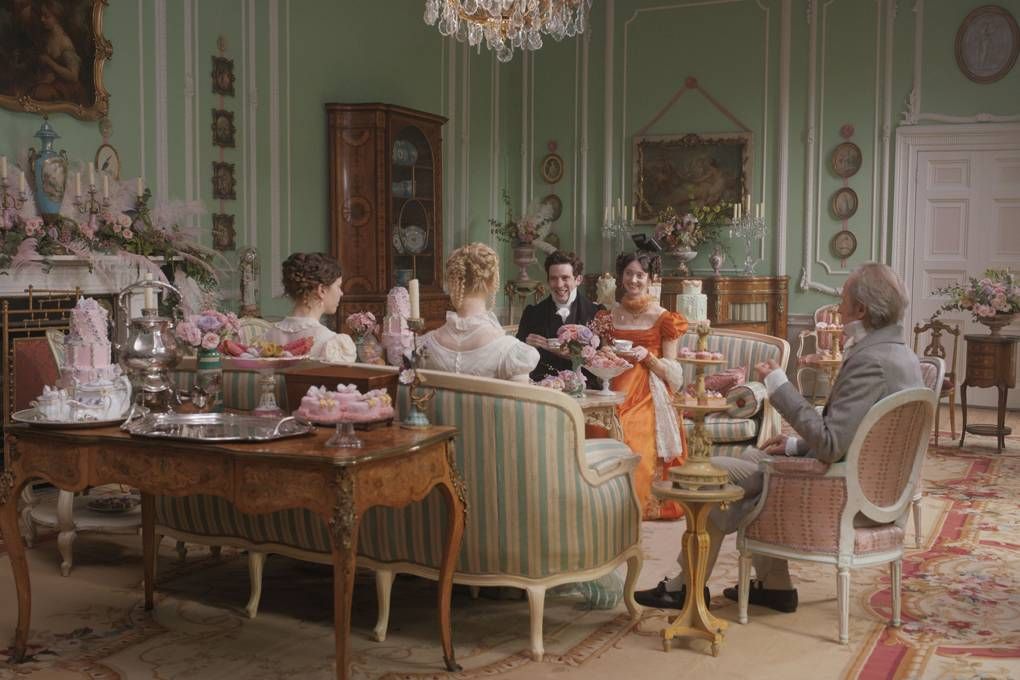
Interesting thing: the way in which Emma and Mr. Knightley’s houses are portrayed makes them look like neighboring properties, also because in the story their owners are neighbors, but in reality those buildings are not that close. They are, in fact, about 86 miles away from each other and moreover Mr. Knightley’s property is famous, since it was used for the productions of The Crown and Pride and Prejudice (2005). Among other things, Pride and Prejudice shares with Emma. a scene where the guests take a tour of the house (coincidences?). Knightley’s walks cancel the real distance and restore that idea of familiarity between the characters, as well as a peculiarity of his person, which is modesty. He doesn’t flaunt his status (as Emma does) going to her house in a carriage, since the houses are (at least in the story) so close.
His walks are also a perfect example of the beautiful landscapes of the movie, which direct us to the theme of nature represented. Nature is brilliantly used as a metaphor, for example through a puntual choice of flowers in the greenhouse, so that, when Emma flirts with Churchill, she finds herself gathering buttercups, roses and jasmine, commonly related to love. As mentioned, everything in de Wilde’s film is meticulously verified on a historical level (even the breed of sheep that are seen grazing around), so it’s not surprising that the availability of flowers in a certain season and the landscapes are too. This was done to give a vision as close as possible to what Jane Austen must had in mind. In fact, the village where the characters shop and stroll is not far from the places originally conceived by the writer. Furthermore, the fact that the director is a photographer and she has an incredibly artistic look, makes each shot a small picture; if for the interiors this is achieved in symmetrical shots, for the exteriors the eye lost himself in the depth of focus.
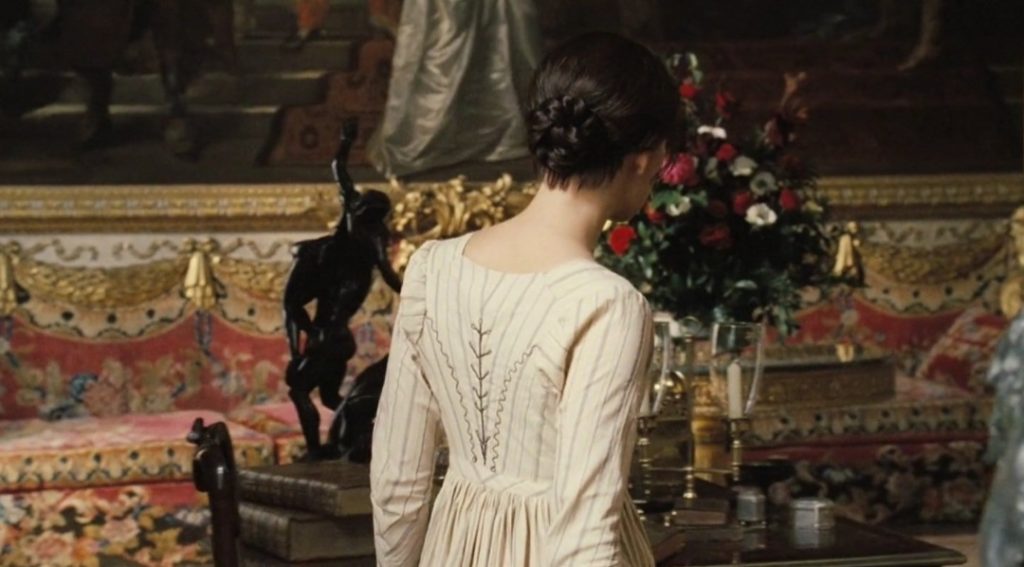
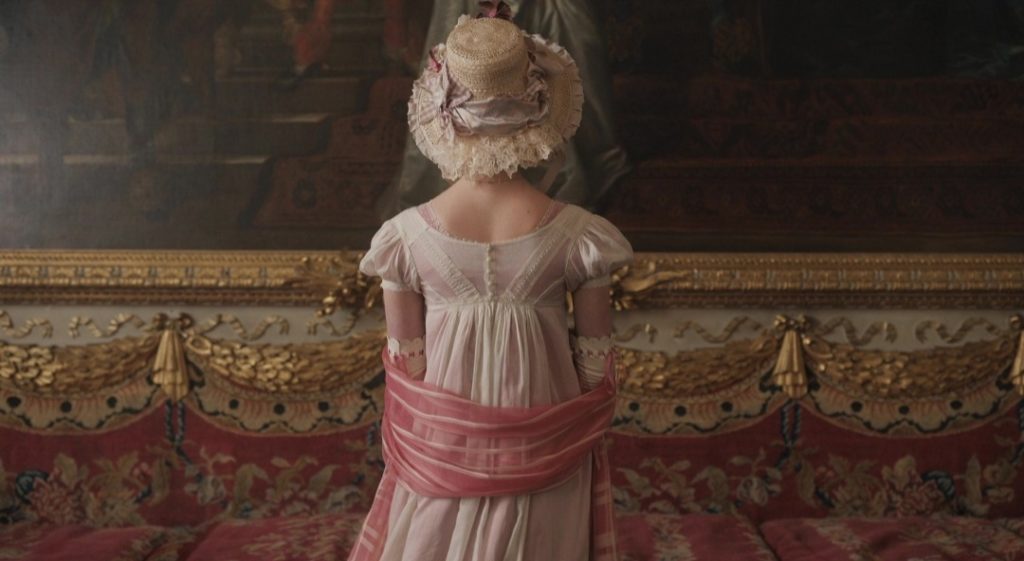
One of the most characterizing elements of the film is the music, which perfectly conveys the spirit of some moments. The soundtrack is partly composed specifically and partly taken from what were the listening at that time (Beethoven and Hayden, but also some songs of the folkloristic tradition). In the first case, it was tailor-made for some characters, who may have a specific theme that evolves with them or instruments that represent them as in spaghetti westerns. In the second case it was chosen for Jane Austen’s great passion for folk music and some songs that inspired others of folk rock, dear to the director, have recovered (Autumn de Wild has worked as a photographer and lived the world of rock and this can be found in many details).
The original part of the soundtrack was composed by Isobelle Waller-Bridge (Phoebe’s sister, yes) who had collaborated to Fleabag and was noticed by the director, interested by the ‘musical sense of humor‘ of the series, especially in the second season. They developed together themes according to the idea that the orchestra was somehow arguing with Emma and also playing with the tones of the actors’ voices, which were reproduced with musical instruments. The composer said there’s a rhythm and a musicality in de Wilde’s composition of the scenes and that contributed to the creation of the music, which followed the movements of the characters and accompanying them.
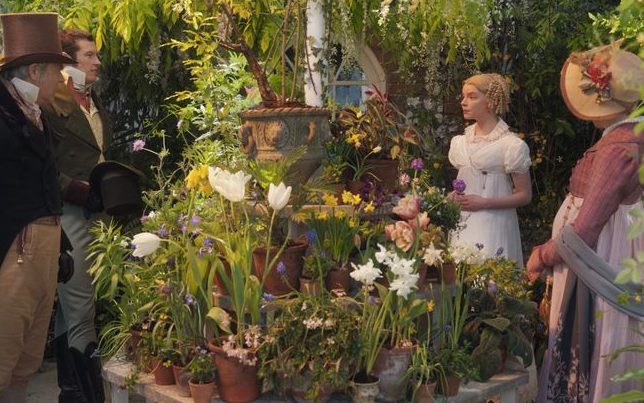
All the aspects seen above are the solid basis on which story rests and, although it’s distant from our everyday life, as it dates back to more than two hundred years ago, it’s undeniable that it speaks to us directly in many points. That’s because, even if the context and setting are so distant from us, it doesn’t necessarily mean the characters are too. Emma is hard to love in the first shots, but that’s part of the greatness of this story , having an anti-hero as the main character. The subject of the film is youth, a youth stained with hybris, which ultimately finds itself experiencing many moments that could also happen to a viewer. There are a series of topical situations, which make it a timeless tale, to which everyone can relate.
Everyone has at least once find himself at a party where someone said something rude creating general embarrassment, or in the situation of realizing they were in love with their bestfriend; Autumn de Wild started with things she lived on her skin like these, and brought out some of the most beautiful scenes in the film. The director’s life is hidden in big and small details, like Emma’s bloody nose, added to the script to humanize the character and also because it often happens to Autumn herself.
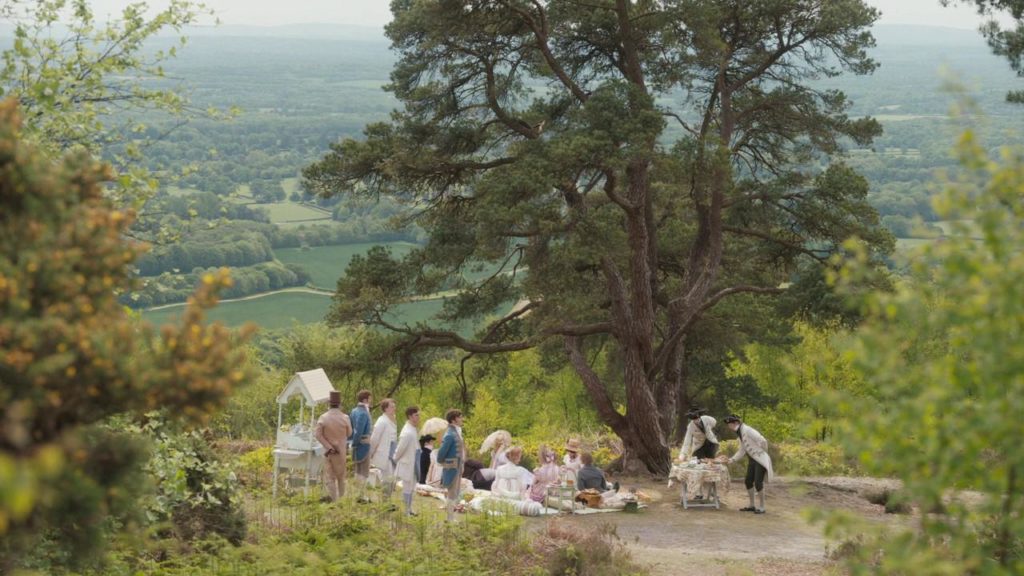
It’s easy to find yourself in the characters, because this version has focused much more on some dynamics, one of all the relationship between Harriet and Emma, in the perspective of growth. In the beginning of the film, Harriet is Emma’s new doll, and can be directed by her to a choice rather than another. The further the story goes, the more Emma sees her plans for Harriet fade and finds herself with a friend who is disconsolate and disillusioned about her marriage prospects. This does not change her, because she still remains true to herself, but it makes her grow and humbles her. At the same time, it changes her best friend, making her, for example, capable of use her voice more when she talks to Emma.
The characters are young and as young girls they behave: they change their opinion of each other over time, sometimes they are unreasonable, sometimes they are naive and above all they have that energy, those looks, which are summed up very well in the dance scene, for which everyone speaks with their eyes. Like any self-respecting costume movie, dance is used as a moment of meeting and contact, because historically it was the only time when people could be so close, physical and alive. It is also a metaphor for Emma’s point of view, who unsuccessfully seeks Churchill’s complicity only to find herself (literally, thanks to the dance) in Knightley’s arms.
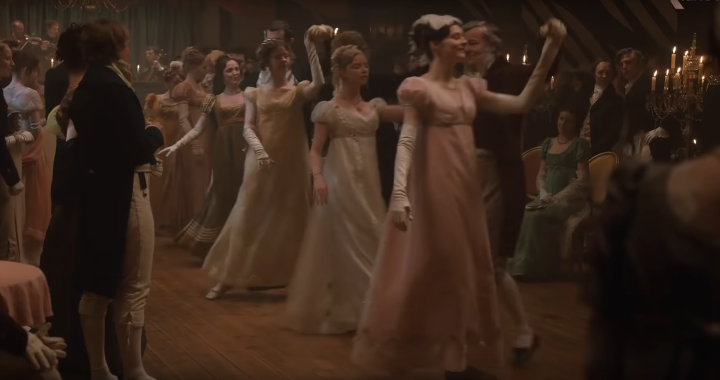
The very young and very good cast renders the nuances well, and above all the familiarity or detachment that is created in one moment rather than another. One of the best actors is Johnny Flynn, who plays Knightley, who from the very first scene in which he appears is clear will be special. In fact, in that first scene Autumn de Wild wanted to show how the aristocrats were dressed and how he and Emma had the same basic clothes. So Knightley is dressed by his servants, reversing the traditional costume film topos of dressing a woman.
His character immediately seems different, from the clothes: he’s linked to Emma and often argues with her. He’s the only one who says something to her when her attitude is unbereable. He does that only to make her act less like a girl and more like a woman, but there’s an underlying sweetness in his character, which probably belongs to the family. In the final scene, indeed, both he and his brother are moved and shed a few tears at the wedding. These details and many others outline a different idea around masculinity, which always follows that perspective of familiarity that the film creates scene after scene.
A familiarity that finds its strength also in what I like to define as the ‘realistic component‘ that is present several times in the narrative. Some examples are when Emma lifts her dress to warm up herself in front of the fireplace, or when Miss Martin has the hem of the dress wet for the rain, or when the sheep are grazing in front of the houses, or when someone eats too quickly at the dinner table. All these little details give characters lifeblood and make us emphatize. Among other things, they were used wisely to let the comic streak out of the story and not to impose it rigidly from the outside.
Autumn de Wilde has reconstructed this world in detail and filled it with a sincere youth, she did it with passion and affection towards the story and its characters. If Jane Austen saw the film she could not help but confirm that it’s the definitive transposition of the story (not surprisingly there’s a point in the title) … then she would probably cry for the ending as well.
Costanza Rossi
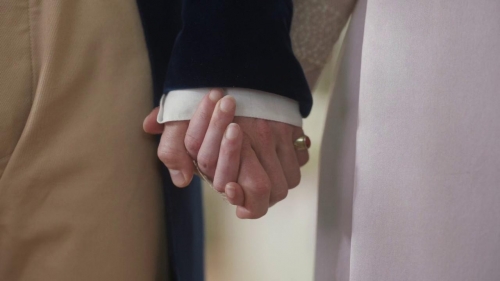
SOURCES: costume design https://fashionista.com/2020/02/emma-movie-autumn-de-wilde-interview-costumes + analysis https://youtu.be/SKzM9ZM2eHY & https://youtu.be/KAo8ehvkom4 + Alexandra Byrne’s interview https://youtu.be/k349Gpdjlnc & https://youtu.be/99JheEU7OsQ
set design https://www.architecturaldigest.com/story/emma-set-design + locations https://www.visitbritain.com/gb/en/where-to-see-emma-filming-locations + the importance of flowers https://www.tatler.com/article/floristry-in-film-emma
interview with the composer Isobel Waller-Bridge https://www.focusfeatures.com/article/interview_composer_isobel-waller-bridge/ + interview to the cast and to the set designer on the set https://youtu.be/UwbrG89Uwkk + interview to the director and lead actress https://youtu.be/QyDhhwDq-S4 + Harriet and ‘Clueless’ for Autumn de Wild https://www.indiewire.com/2020/02/emma-director-autumn-de-wilde-jane-austen-interview-1202212448/
why there’s a period at the end of the movie title https://www.bbcamerica.com/blogs/emma-director-autumn-de-wilde-explains-why-there-is-a-period-at-the-end-of-the-movie-title–16722 + first scene of the film https://www.artofthetitle.com/title/emma-2020/
